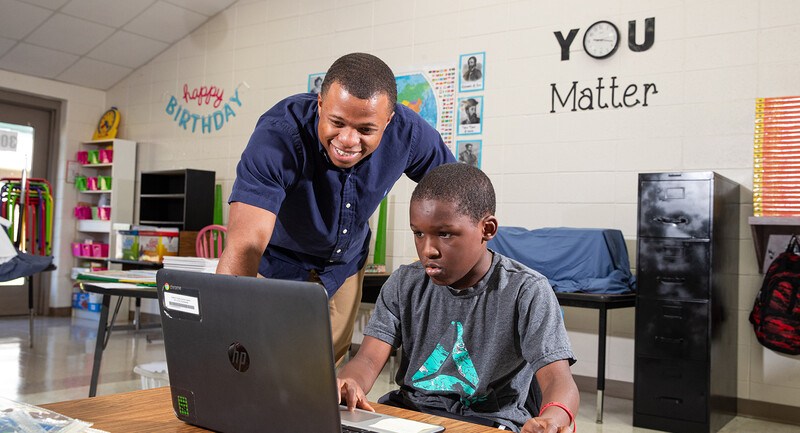When educators move into administrative roles, they can quickly lose sight of what it's like to be in the classroom. They rarely have the chance to deepen their understanding of current practices. Over time, they become further removed from the work of instruction. Meanwhile, exceptional classroom teachers are becoming experts in the latest teaching practices, but they often lack the skills or opportunities to lead capacity-building efforts in their schools. These opposing trajectories create a wall that has traditionally divided teaching and leading—with administrators and teachers unable to fully view one another's practices.
We can begin to dismantle this wall by creating a new element of school leadership—one that we call teachership. Teachership weaves exceptional leading with exceptional teaching. It emerges when administrators engage in classroom-based professional learning and exemplary teachers lead from within the classroom. By working together to tackle the unique challenges of teaching and leading, administrators and teachers can develop a deep level of understanding for other roles. The end result is administrators and teachers who work with rather than against one another to improve school culture, teaching practices, and student learning.
In the Sandbox
Teachership doesn't happen accidentally; rather it develops as a result of intentional, job-embedded professional learning experiences that we call professional sandboxes. In the technology world, a sandbox refers to a space designed to safely test and learn about the functionality of new software before it goes live. In school settings, professional sandboxes can take the form of curriculum writing initiatives, professional learning community activities, and lesson studies. The sandboxes are designed to develop teachership in a safe and supportive environment. They are non-evaluative experiences in which educators can feel comfortable exposing their own vulnerabilities and learning needs.
Although each is unique, all professional sandboxes are intentional, contextual, sustainable, and evidence-based. Educators follow a set of questions and prompts before, during, and after the professional learning experience.
Professional sandboxes are designed along a continuum to account for differences in the intensity of time, resources, and level of risk involved (Bean & Ippolito, 2016). Level 1 sandboxes are typically low-intensity and focus on improving culture. These sandboxes include strategy walks, shadowing, and curriculum writing. Although these examples may seem like common practices that already exist in many schools, Level 1 professional sandboxes are different because they follow an intentional design focused on improving school culture. Rather than serving as stand-alone activities, Level 1 sandboxes are implemented as a foundational and cohesive approach to developing teachership.
Level 2 sandboxes seek to improve practice and are considered more intensive because they require more time and a higher level of commitment. These sandboxes can take the form of lab classrooms, professional learning communities, and guided inquiry.
Level 3 sandboxes are the most intense and often require critical, yet non-evaluative feedback from colleagues. Examples include instructional rounds, lesson studies, and peer observations. Let's take a look at how professional sandboxes have been used to develop teachership in schools.
Level 1: Strategy Walks
A strategy walk is a non-evaluative process in which participants visit multiple classrooms to see a specific strategy being used in different settings. The purpose of strategy walks is to provide participants with an opportunity to browse, borrow, and build from colleagues, thus enhancing their own understanding of a specific strategy. The needs of the participants should be considered when determining where a strategy walk takes place—some occur in an educator's own school, and others happen within the district or in nearby districts.
To be most effective, strategy walks should be part of a cycle of professional learning. After learning about a new strategy (such as integrating technology or boosting student engagement) in a workshop, professional learning community, or book study, participants go on strategy walks to see the strategy in action. At the end of the walk, the visiting team collects ideas about how the strategy can be used in a variety of settings.
Lauren Sargent, a literacy coach in Southern Tioga School District in Blossburg, Pennsylvania, incorporates strategy walks into many of the professional learning workshops she conducts for teachers. Lauren recently cofacilitated a workshop in which teachers and administrators spent the morning learning about strategies to engage students in self-directed, authentic writing experiences. In the afternoon, the educators took strategy walks to see what these strategies looked like in practice. They observed how teachers created opportunities for students to self-select writing topics and used anchor charts and word walls to promote self-direction.
This level 1 sandbox supported the development of teachership because administrators had the opportunity to get into classrooms to see an evidence-based instructional strategy in action. Meanwhile, teachers stepped into leadership roles by being part of the walking team. Some teachers hosted the walking team in their classrooms, and others led the walks and facilitated discussions before, during, and after the activity. Together, administrators and teachers contributed to a culture of collaboration. Both ended the day with new ideas to apply to their individual roles.
Level 2: Lab Classrooms
A lab site is a fully functioning classroom taught by an exemplary teacher, which also doubles as a professional learning environment. Lab classrooms are considered level 2 professional sandboxes because they provide multiple opportunities for teachers and administrators to work side-by-side to improve teaching practices in the context of functional classrooms. Creating this setting and establishing visitation protocols requires more time and resources than level 1 sandboxes do. However, it also has more potential for changing practice because it provides job-embedded, personalized, professional learning. For example, an administrator who wants to learn more about close reading can watch the lab teacher teach a lesson, can co-teach a lesson, or can take the wheel and teach a lesson (with the lab teacher offering feedback).
The Harrisburg School District in Pennsylvania used lab classrooms as one part of its professional development system. Kelly Sherbo and Susan Laughman, two lab site teachers, provided visiting teachers and administrators with opportunities to observe, teach, and engage in evidence-based literacy practices. After learning about writing conferences, for instance, visitors conducted conferences with students in the lab classrooms and opted to receive peer-to-peer feedback on their progress.
Lab classrooms are ideal for developing teachership because educators learn best when they actively engage in professional learning communities in the context of classroom practice. Collective professional learning in trusting environments is the basis for inquiry, risk-taking, and reflection on one's own practice (Wei et al., 2009).
Level 3: Instructional Rounds
An instructional round is a non-evaluative process during which teams of educators visit multiple classrooms over time to examine a problem of practice in a systematic, purposeful, and focused way (City et al., 2009). This process is based on the work of education researcher Richard Elmore, who asserts that we learn to do instructional work by being in the work—not by talking about it, telling other people to do it, or having experts do it for us.
We have used instructional rounds as a level 3 professional sandbox. When Sam (coauthor of this article), superintendent of Southern Tioga School District, noticed that his district's administrative team (made up of principals, curriculum coordinators, and special education coordinators) needed to go beyond a checklist approach to classroom visits, he tapped the region's education service agency for support. Christina, who serves as the agency's director of professional learning (and is coauthor of this article), recommended instructional rounds.
Over the next three years, we worked together to develop the district's internal capacity to use instructional rounds. We began by identifying a problem of practice, which the team framed as a question: To what extent are our students engaged in their learning? To answer this question, Christina worked with the administrative team to follow the instructional round process for collecting, vetting, and analyzing evidence related to student engagement.
To create an environment in which principals would feel safe revealing their own vulnerabilities about teaching and learning, we devoted the first two years of instructional rounds to working with just the administrative team. During this time, the team created a common body of knowledge and language about students' cognitive, relational, and behavioral engagement.
Before joining the administrators in instructional rounds, teachers spent six months working closely with the district's director of curriculum, instruction, and assessment and engaged in a book study about instructional rounds. This experience allowed teachers to deepen their knowledge of instructional rounds, to better understand characteristics of school improvement, and to build training relationships.
Now in the third year of the project, administrators and teachers are fully partnering in the instructional round process together. The district team now includes 16 administrators and teacher leaders who spend one day each month doing instructional rounds. During a recent round, the team met for about 30 minutes with the principal of a host school to learn about the school's successes and needs related to student engagement. The team then divided into four traveling groups to visit classrooms for 15–20 minutes. The groups collected evidence of student engagement (including asking students questions like, "What are you learning? Why are you learning that?") and later debriefed on what they noticed on their visits.
In this example of a level 3 professional sandbox, teachership emerges as administrators develop a greater understanding of teaching and learning, while teachers have the opportunity to make a large-scale impact at the school and district level. Instructional rounds give teachers and administrators the opportunity to work side-by-side in developing common knowledge about good instructional practice and about the leadership and learning needed to support particular practices.
A Culture of Windows
The concept of teachership and the practice of professional sandboxes are now more relevant than ever. The Every Student Succeeds Act (ESSA) recognizes evidence-based professional learning practices in which all educators have opportunities to collaborate, engage in job-embedded learning, and immediately apply their new skills to improve teaching and learning. Under ESSA, changes to Title II funding (as currently allotted) mean that professional development expands beyond core-subject classroom teachers to include teachers in all subjects, as well as administrators, school leaders, and other school staff. Professional sandboxes provide districts with sustainable, low-cost professional learning that meets those requirements.
Further, at a time when many schools face significant challenges, we must acknowledge that we can't begin to solve these problems until we can truly empathize with others in the building. Teachership develops an authentic understanding for what it feels like to do someone else's work—to walk in a colleague's shoes. Teachership and professional sandboxes can knock down walls that separate traditional roles and in their place create windows for educators to see into one another's work, allowing educators in all roles to both learn and lead.









